Read Lesson
| Site: | CMI School |
| Course: | History | Social Science |
| Book: | Read Lesson |
| Printed by: | Guest user |
| Date: | Wednesday, 25 June 2025, 2:43 AM |
Description
Our Past II
4

THE MUGHAL EMPIRE
Ruling as large a territory as the Indian subcontinent with such a diversity of people and cultures was an extremely difficult task for any ruler to accomplish in the Middle Ages. Quite in contrast to their predecessors, the Mughals created an empire and accomplished what had hitherto seemed possible for only short periods of time. From the latter half of the sixteenth century they expanded their kingdom from Agra and Delhi, until in the seventeenth century they controlled nearly all of the subcontinent. They imposed structures of administration and ideas of governance that outlasted their rule, leaving a political legacy that succeeding rulers of the subcontinent could not ignore. Today the Prime Minister of India addresses the nation on Independence Day from the ramparts of the Red Fort in Delhi, the residence of the Mughal emperors.
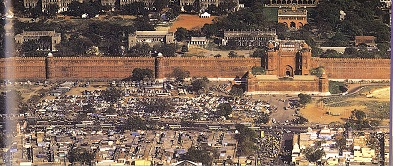
Fig. 1 The Red Fort.
Who were the Mughals?
The Mughals were descendants of two great lineages of rulers. From their mother’s side they were descendants of Genghis Khan (died 1227), ruler of the Mongol tribes, China and Central Asia. From their father’s side they were the successors of Timur (died 1404), the ruler of Iran, Iraq and modern-day Turkey. However, the Mughals did not like to be called Mughal or Mongol. This was because Genghis Khan’s memory was associated with the massacre of innumerable people. It was also linked with the Uzbegs, their Mongol competitors. On the other hand, the Mughals were proud of their Timurid ancestry, not least of all because their great ancestor had captured Delhi in 1398.

? Do you think this painting suggests that the Mughals claimed kingship as a birthright?
They celebrated their genealogy pictorially, each ruler getting a picture made of Timur and himself. Take a look at Figure 2, which is somewhat like a “group photograph”.
Mughal Military Campaigns
Babur, the first Mughal emperor (1526-1530), succeeded to the throne of Ferghana in 1494 when he was only 12 years old. He was forced to leave his ancestral throne due to the invasion of another Mongol group, the Uzbegs. After years of wandering he seized Kabul in 1504. In 1526 he defeated the Sultan of Delhi, Ibrahim Lodi, at Panipat and captured Delhi and Agra.

Fig. 3 Mughal army on campaign.
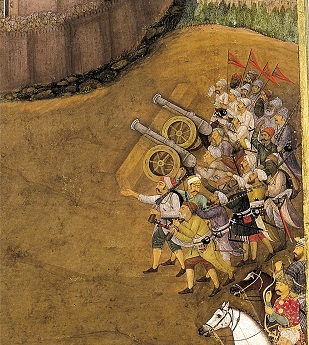
Fig. 4 Cannons were an important addition in sixteenth-century warfare. Babur used them effectively in the first battle of Panipat.
Table 1 charts some of the major campaigns of the Mughals. Study it carefully and see if you can notice any long-term patterns. You will notice, for example, that the Afghans were an immediate threat to Mughal authority. Note the relationship between the Mughals and the Ahoms (see also Chapter 7), the Sikhs (see also Chapters 8 and 10), and Mewar and Marwar (see also Chapter 9). How was Humayun’s relationship with Safavid Iran different from Akbar’s? Did the annexation of Golconda and Bijapur in Aurangzeb’s reign end hostilities in the Deccan?
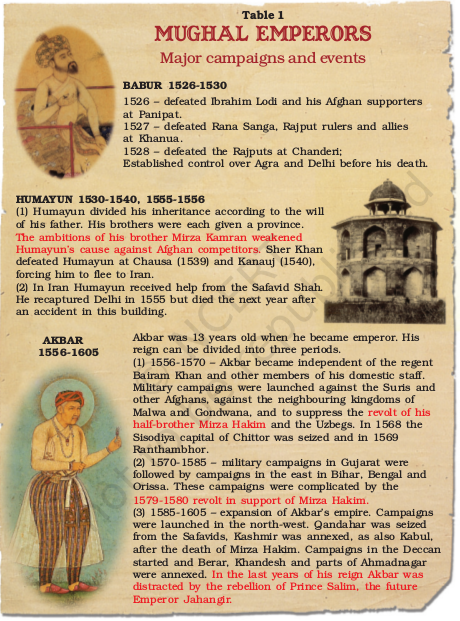


Map 1 Military campaigns under Akbar and Aurangzeb.
Mughal Traditions of Succession
The Mughals did not believe in the rule of primogeniture, where the eldest son inherited his father’s estate. Instead they followed the Mughal and Timurid custom of coparcenary inheritance, or a division of the inheritance amongst all the sons. Follow the highlighted passages in Table 1, and note the evidence for rebellions by Mughal princes. Which do you think is a fairer division of inheritance: primogeniture or coparcenary ?
Mughal marriages with the Rajputs
The mother of Jahangir was a Kachhwaha princess, daughter of the Rajput ruler of Amber (modern- day Jaipur). The mother of Shah Jahan was a Rathor princess, daughter of the Rajput ruler of Marwar (Jodhpur).
Mughal Relations with Other Rulers
Take a look at Table 1 once again. You will notice that the Mughal rulers campaigned constantly against rulers who refused to accept their authority. But as the Mughals became powerful many other rulers also joined them voluntarily. The Rajputs are a good example of this. Many of them married their daughters into Mughal families and received high positions. But many resisted as well.
The Sisodiya Rajputs refused to accept Mughal authority for a long time. Once defeated, however, they were honourably treated by the Mughals, given their lands (watan) back as assignments (watan jagir). The careful balance between defeating but not humiliating their opponents enabled the Mughals to extend their influence over many kings and chieftains. But it was difficult to keep this balance all the time. Look at Table 1 again – note that Aurangzeb insulted Shivaji when he came to accept Mughal authority. What was the consequence of this insult?
Mansabdars and Jagirdars
As the empire expanded to encompass different regions the Mughals recruited diverse bodies of people. From a small nucleus of Turkish nobles (Turanis) they expanded to include Iranians, Indian Muslims, Afghans, Rajputs, Marathas and other groups. Those who joined Mughal service were enrolled as mansabdars.
Zat ranking
Nobles with a zat of 5,000 were ranked higher than those of 1,000. In Akbar’s reign there were 29 mansabdars with a rank of 5,000 zat; by Aurangzeb’s reign the number of mansabdars had increased to 79. Would this have meant more expenditure for the state?
The term mansabdar refers to an individual who holds a mansab, meaning a position or rank. It was a grading system used by the Mughals to fix (1) rank, (2) salary and (3) military responsibilities. Rank and salary were determined by a numerical value called zat. The higher the zat, the more prestigious was the noble’s position in court and the larger his salary.
The mansabdar’s military responsibilities required him to maintain a specified number of sawar or cavalrymen. The mansabdar brought his cavalrymen for review, got them registered, their horses branded and then received money to pay them as salary.
Mansabdars received their salaries as revenue assignments called jagirs which were somewhat like iqtas. But unlike muqtis, most mansabdars did not actually reside in or administer their jagirs. They only had rights to the revenue of their assignments which was collected for them by their servants while the mansabdars themselves served in some other part of the country.
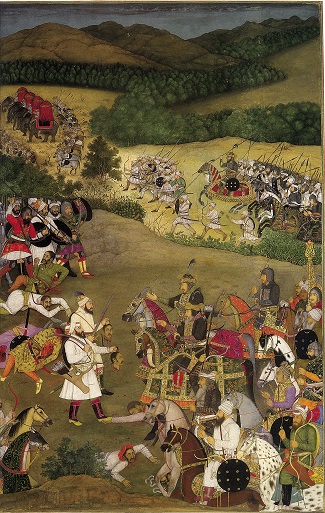
Fig. 5 A mansabdar on march with his sawars.
In Akbar’s reign these jagirs were carefully assessed so that their revenues were roughly equal to the salary of the mansabdar. By Aurangzeb’s reign this was no longer the case and the actual revenue collected was often less than the granted sum. There was also a huge increase in the number of mansabdars, which meant a long wait before they received a jagir. These and other factors created a shortage in the number of jagirs. As a result, many jagirdars tried to extract as much revenue as possible while they had a jagir. Aurangzeb was unable to control these developments in the last years of his reign and the peasantry therefore suffered tremendously.
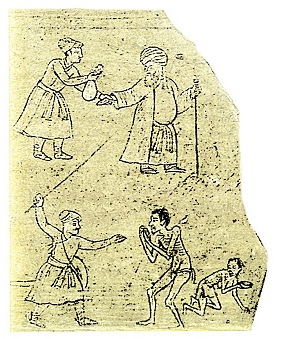
Fig. 6 Details from a miniature from Shah Jahan’s reign depicting corruption in his father’s administration:
(1) a corrupt officer receiving a bribe and
(2) a tax-collector punishing poor peasants.
Zabt and Zamindars
The main source of income available to Mughal rulers was tax on the produce of the peasantry. In most places, peasants paid taxes through the rural elites, that is, the headman or the local chieftain. The Mughals used one term – zamindars – to describe all intermediaries, whether they were local headmen of villages or powerful chieftains.
Akbar’s revenue minister, Todar Mal, carried out a careful survey of crop yields, prices and areas cultivated for a 10-year period, 1570-1580. On the basis of this data, tax was fixed on each crop in cash. Each province was divided into revenue circles with its own schedule of revenue rates for individual crops. This revenue system was known as zabt. It was prevalent in those areas where Mughal administrators could survey the land and keep very careful accounts. This was not possible in provinces such as Gujarat and Bengal.
In some areas the zamindars exercised a great deal of power. The exploitation by Mughal administrators could drive them to rebellion. Sometimes zamindars and peasants of the same caste allied in rebelling against Mughal authority. These peasant revolts challenged the stability of the Mughal Empire from the end of the seventeenth century.
Akbar Nama and Ain-i Akbari
Akbar ordered one of his close friends and courtiers, Abul Fazl, to write a history of his reign. Abul Fazl wrote a three-volume history of Akbar’s reign, titled Akbar Nama. The first volume dealt with Akbar’s ancestors and the second volume recorded the events of Akbar’s reign. The third volume is the Ain-i Akbari. It deals with Akbar’s administration, household, army, the revenues and the geography of his empire. It also provides rich details about the traditions and culture of the people living in India. The most interesting aspect about the Ain-i Akbari is its rich statistical details about things as diverse as crops, yields, prices, wages and revenues.
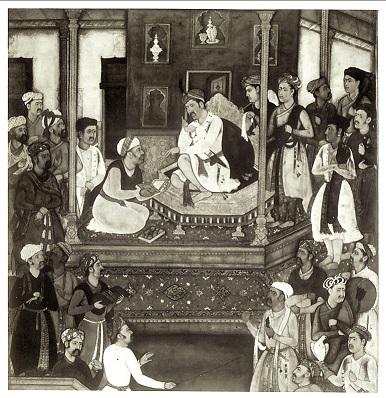
Fig. 7Akbar recieving the Akbar Nama from Abul Fazl.
A Closer Look: Akbar’s Policies
The broad features of administration were laid down by Akbar and were elaborately discussed by Abul Fazl in his book, the Akbar Nama, in particular in its last volume, the Ain-i Akbari.
Abul Fazl explained that the empire was divided into provinces called subas, governed by a subadar who carried out both political and military functions. Each province also had a financial officer or diwan. For the maintenance of peace and order in his province, the subadar was supported by other officers such as the military paymaster (bakhshi), the minister in charge of religious and charitable patronage (sadr), military commanders (faujdars) and the town police commander (kotwal).
Nur Jahan’s influence in Jahangir’s court
Mehrunnisa married the Emperor Jahangir in 1611 and received the title Nur Jahan. She remained extremely loyal and supportive to the monarch. As a mark of honour, Jahangir struck silver coins bearing his own titles on one side and on the other the inscription “struck in the name of the Queen Begum, Nur Jahan”.
The adjoining document is an order (farman) of Nur Jahan. The square seal states, “Command of her most Sublime and Elevated Majesty Nur Jahan Padshah Begum”. The round seal states, “by the sun of Shah Jahangir she became as brilliant as the moon; may Nur Jahan Padshah be the lady of the age”.
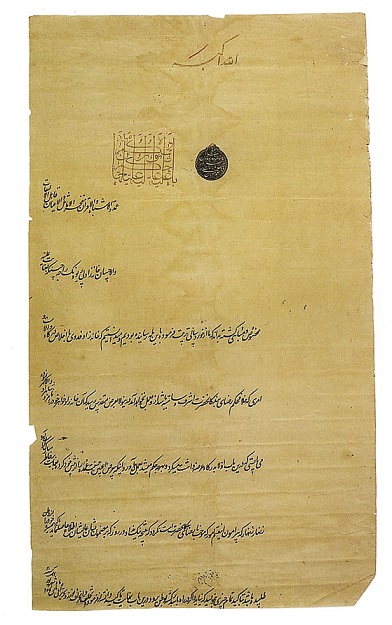
Fig. 8 Nur Jahan’s farman.
Akbar’s nobles commanded large armies and had access to large amounts of revenue. While they were loyal the empire functioned efficiently but by the end of the seventeenth century many nobles had built independent networks of their own. Their loyalties to the empire were weakened by their own self-interest.
Dogma
A statement or an interpretation declared as authoritative with the expectation that it would be followed without question.
Bigot
An individual who is intolerant of another person’s religious beliefs or culture.
While Akbar was at Fatehpur Sikri during the 1570s he started discussions on religion with the ulama, Brahmanas, Jesuit priests who were Roman Catholics, and Zoroastrians. These discussions took place in the ibadat khana. He was interested in the religion and social customs of different people. Akbar’s interaction with people of different faiths made him realise that religious scholars who emphasised ritual and dogma were often bigots. Their teachings created divisions and disharmony amongst his subjects. This eventually led Akbar to the idea of sulh-i kul or “universal peace”. This idea of tolerance did not discriminate between people of different religions in his realm. Instead it focused on a system of ethics – honesty, justice, peace – that was universally applicable. Abul Fazl helped Akbar in framing a vision of governance around this idea of sulh-i kul. This principle of governance was followed by Jahangir and Shah Jahan as well.
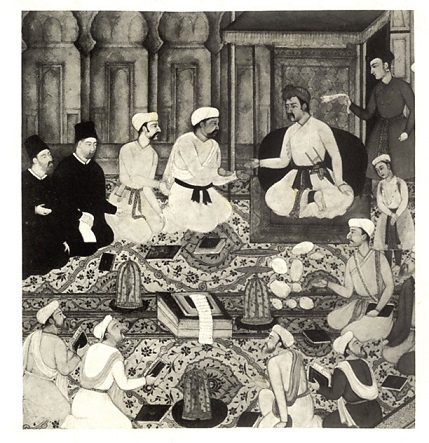
Fig. 9 Akbar holding discussions with learned individuals of different faiths in the ibadat khana.
? Can you identify the Jesuit priests in this picture?
Sulh-i kul
Jahangir, Akbar’s son, described his father’s policy of sulh-i kul in the following words:
As in the wide expanse of the divine compassion there is room for all classes and the followers of all creeds, so … in his Imperial dominions, which on all sides were limited only by the sea, there was room for the professors of opposite religions, and for beliefs, good and bad, and the road to intolerance was closed. Sunnis and Shias met in one mosque and Christians and Jews in one church to pray. He consistently followed the principle of “universal peace” (sulh-i kul).
The Mughal Empire in the Seventeenth Century and After
The administrative and military efficiency of the Mughal Empire led to great economic and commercial prosperity. International travellers described it as the fabled land of wealth. But these same visitors were also appalled at the state of poverty that existed side by side with the greatest opulence. The inequalities were glaring. Documents from the twentieth year of Shah Jahan’s reign inform us that the highest-ranking mansabdars were only 445 in number out of a total of 8,000. This small number – a mere 5.6 per cent of the total number of mansabdars – received 61.5 per cent of the total estimated revenue of the empire as salaries for themselves and their troopers.
The Mughal emperors and their mansabdars spent a great deal of their income on salaries and goods. This expenditure benefited the artisans and peasantry who supplied them with goods and produce. But the scale of revenue collection left very little for investment in the hands of the primary producers – the peasant and the artisan. The poorest amongst them lived from hand to mouth and they could hardly consider investing in additional resources – tools and supplies – to increase productivity. The wealthier peasantry and artisanal groups, the merchants and bankers profited in this economic world.
The enormous wealth and resources commanded by the Mughal elite made them an extremely powerful group of people in the late seventeenth century. As the authority of the Mughal emperor slowly declined, his servants emerged as powerful centres of power in the regions. They constituted new dynasties and held command of provinces like Hyderabad and Awadh. Although they continued to recognise the Mughal emperor in Delhi as their master, by the eighteenth century the provinces of the empire had consolidated their independent political identities. We will read more about them in Chapter 10.
Kings and Queens
There were several great monarchs – all near-contemporaries – in different parts of the world in the sixteenth century.
These included the ruler of Ottoman Turkey, Sultan Suleyman 1520-1566. During his rule the Ottoman state expanded into Europe, seizing Hungary and besieging Austria. His armies also seized Baghdad and Iraq. Much of north Africa, all the way into Morocco, acknowledged Ottoman authority. Suleyman also reconstructed the Ottoman navy. Its domination over the eastern Mediterranean brought the navy into competition with Spain. In the Arabian Sea it challenged the Portuguese. The monarch was given the title of “al-Qanuni” (the “lawgiver”) because of the large number of regulations (qanun) passed during his reign. These were aimed to standardise administrative procedures throughout the expanding domains of the empire and specifically to protect the peasantry from forced labour and extraordinary taxes. Later, in the seventeenth century, when public order declined in the Ottoman domains, the reign of Suleyman Qanuni was remembered as a period of ideal governance.
Find out more about Akbar’s other contemporaries – the ruler of England, Queen Elizabeth I (1558-1603); the Safavid ruler of Iran, Shah Abbas (1588-1629); and the more controversial Russian ruler, Czar Ivan IV Vasilyevich, also called “Ivan the Terrible” (1530-1584).

Imagine
You have inherited a kingdom. (Remember Babur and Akbar were about your age when they became rulers). How would you make your kingdom stable and prosperous?
Let’s recall
1. Match the following:
mansab Marwar
Mongol governor
Sisodiya Rajput Uzbeg
Rathor Rajput Mewar
Nur Jahan rank
subadar Jahangir
2. Fill in the blanks:
(a) The capital of Mirza Hakim, Akbar’s half-brother, was ____________.
(b) The five Deccan Sultanates were Berar, Khandesh, Ahmadnagar, ____________ and _________________.
(c) If zat determined a mansabdar’s rank and salary, sawar indicated his ____________ .
(d) Abul Fazl, Akbar’s friend and counsellor, helped him frame the idea of ____________ so that he could govern a society composed of many religions, cultures and castes.
3. What were the central provinces under the control of the Mughals?
4. What was the relationship between the mansabdar and the jagir?
Let’s understand
5. What was the role of the zamindar in Mughal administration?
6. How were the debates with religious scholars important in the formation of Akbar’s ideas on governance?
7. Why did the Mughals emphasise their Timurid and not their Mongol descent?
Let’s discuss
8. How important was the income from land revenue to the stability of the Mughal Empire?
9. Why was it important for the Mughals to recruit mansabdars from diverse backgrounds and not just Turanis and Iranis?
10. Like the Mughal Empire, India today is also made up of many social and cultural units. Does this pose a challenge to national integration?
11. Peasants were vital for the economy of the Mughal Empire. Do you think that they are as important today? Has the gap in the income between the rich and the poor in India changed a great deal from the period of the Mughals?
Let’s do
12. The Mughal Empire left its impact on the different regions of the subcontinent in a variety of ways. Find out if it had any impact in the city, village or region in which you live.
Keywords
Mughal
mansab
jagir
zat
sawar
sulh-i kul
primogeniture
coparcenary
zabt
zamindar